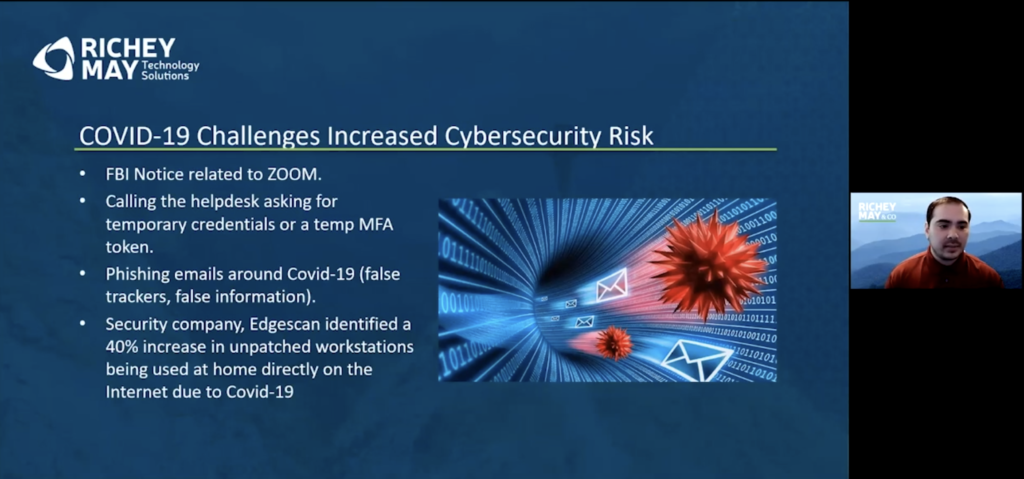
Richey May Technology: Remote Security Challenges Continue Into 2021
Media and entertainment companies have adapted to remote work since the start of the COVID-19 pandemic, but they continue to face security challenges, according to Jacob Stremler, cybersecurity engineer at Richey May Technology (RMTS) Solutions, a Trusted Partner Network qualified assessor and a self-described “certified ethical hacker.”
2020 was a “very interesting year“ in which “Hollywood stayed home” and “we see that trend continuing in 2021,” he said during the WFH & Disruption breakout session “Hollywood Stays Home in 2021” at the March 16 Smart Content Summit.
 “We’ve seen the way our businesses operate and the way Hollywood operates has significantly changed,” he told viewers, noting: “We went overnight from working inside a studio to now needing to work on content and manage your business from home. So that’s been challenging to say the least.”
“We’ve seen the way our businesses operate and the way Hollywood operates has significantly changed,” he told viewers, noting: “We went overnight from working inside a studio to now needing to work on content and manage your business from home. So that’s been challenging to say the least.”
Sports teams “overnight had to come up with solutions to provide remote access to content and to enable their end users or employees to work,” he pointed out. “Not only does this impact the IT team, the sport team, operations, employees in general but even management,” he said, noting “management styles have had to change.”
Security Woes
“There was a big rush to get remote access” last year amid the start of the pandemic and, in the process, “security was pushed to the wayside,” according to Stremler.
COVID-19 challenges increased cybersecurity risk, he said, noting the FBI issued a warning about potential Zoom security vulnerabilities and “Zoom-bombing” in which hackers drop in on video conference sessions without permission.
We also saw scammers trying to convince help desks to send them new passwords or temporary tokens so that they could either access organizations’ email accounts or access their online video collaboration platforms, he pointed out.
We also saw a large increase in phishing emails around COVID-19, including false trackers and false information. Now we’re seeing that around the vaccine also.
“Organizations need to be aware of this and have controls in place to ensure that these challenges can be met,” Stremler said.
Security company Edgescan identified a 40% increase in unpatched workstations being used at home directly on the Internet due to the pandemic.
Meanwhile, 55% of U.S. businesses suffered ransomware attacks in the past 12 months, according to third-party data cited by RMTS.
 What Do We Do Now?
What Do We Do Now?
M&E organizations have started looking at virtualizing their productions, Stremler went on to say.
For example, Peter Jackson’s Weta Digital effects company in New Zealand announced in late 2020 that it had gone “all in” on the cloud, Stremler said. It’s relying on new technology from a cloud workflow perspective and also working with some older technologies to try and produce animated content entirely remotely so its creative staff can work remotely around the world, he pointed out.
“It’ll be really interesting to see how this move plays out because this is pretty much a first,” he noted, predicting other studios, especially animated ones, will follow Weta’s lead.
Virtual desktop technology has been around for the past 20 years and there continue to be “pros and cons” to it, he said. “Like any solution, it will be very dependent upon your environment and your workflows.”
There are several factors that organizations must consider when it comes to deciding on a shift to virtual desktops or not, including: Licensing costs, application compatibility, administration, security and the need to have mobility wherever one is, he said.
Moving to a Desktop-as-a-Service (DaaS) system comes with specific licensing costs, he warned. With DaaS, you pay for software, hardware and administration as a service, he noted. Each organization should have a plan on how much they will operate from the cloud vs. what they want to take responsibility for and this should be taken into consideration before rolling everything out, according to Stremler.
“Moving to the cloud is not an all-in-one answer – there will be challenges,” he warned. But he was quick to add: “I think the pros far outweigh the cons here.”
 There are “drawbacks” to a DaaS solution and “there are challenges that you’ll face when migrating your systems to the cloud,” he said. For example, “some legacy applications are difficult to migrate to the cloud and that’s part of the challenge that you’ll have to face,” he noted, adding: “This just requires testing and proof of concept before you move and before you commit to that.”
There are “drawbacks” to a DaaS solution and “there are challenges that you’ll face when migrating your systems to the cloud,” he said. For example, “some legacy applications are difficult to migrate to the cloud and that’s part of the challenge that you’ll have to face,” he noted, adding: “This just requires testing and proof of concept before you move and before you commit to that.”
On the other hand, there are some legacy applications that are “extremely easy to virtualize,” he pointed out.
One major advantage of DaaS environments is they “improve your mobility” and “users can access content from wherever they are in the globe as long as they have Internet,” he said.
Click here to access video of the presentation.
Click here to download presentation.
The Smart Content Summit was produced by MESA and the Smart Content Council, and was sponsored by Microsoft Azure, Whip Media Group, Richey May Technology Solutions, BeBanjo, Digital Nirvana, Softtek, 24Notion, EIDR, The Quorum and Signiant.
